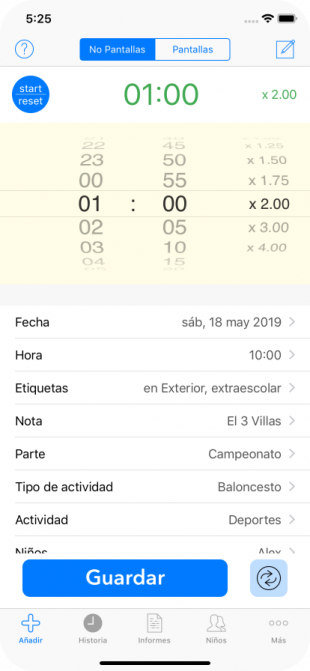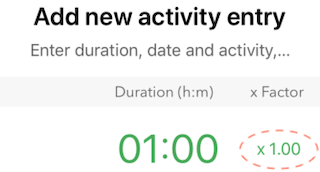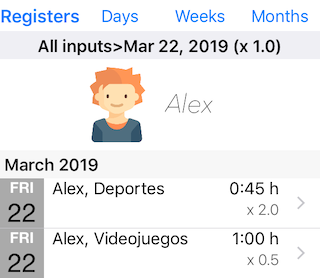
Multiplying factor of the duration of activities
In the application Settings screen you can activate two advanced features related to the duration of the activity entries. The first one is the timer. The second functionality is the Factor multiplier of the duration of the activity.
Once the Multiplier Factor is enabled in the App Settings, an additional column will appear to the right of the time duration value of the activity we are editing, in the Add tab.

The Factor is a number that we can use to multiply the duration of an activity. When saving a new activity entry, both the activity duration value (the actual duration of the activity) and the Factor will be saved.
This allows us to generate reports and graphs comparing the activities under two different time scales, a first one with the real durations and a second one with the factor applied:


- Actual activity times: Activity time = Duration
- Factorized activity times: Activity time = Duration x Factor
This factor will be displayed in the activity History.

The Factor can take values lower than the unit, including the zero value, to reduce the duration of an activity. Or on the other side, it can take values greater than unity, if we want is to increase the duration of the activity, by multiplying it by the factor we associate with it.
By default, we will use a Factor value equal to 1.0, so that when applying the factor, the durations resulting from multiplying the real Duration by the Factor will remain the same as the real Durations. And we will use a different Factor value to enhance or reduce the activity duration in some specific activities. Enclose you can see some examples of its use.
Example 1. Strengthen the effort
Being the case that we are promoting sports activity versus video games, and that our child already trains his favorite sport weekly, and performs the corresponding matches at the weekend.
Being the case that we have decided that for every hour of sport they do, we allow them to play with video games for one hour, so that 3 hours of training plus 1 hour match a week, it will allow them to play 4 hours video games a week, maintaining the balance between Sport versus Videogames.
It would be possible that tournaments appear throughout the year (Christmas Tournament, etc.). One way to promote our child's participation in the tournament and assess the additional effort could be by rewarding the time spent in the tournament, with a multiplier factor value greater than the unit.
Using a multiplier factor of 2.0, they would be allowed to play two hours of video games for every hour spent playing sports during the tournament, while maintaining the balance of Sports versus Videogames in reports with the Factor applied.
Example 2. Reduce the effect of certain activities
Let's continue with the previous example, in which we are promoting physical activity versus video games, and our child has also been doing a 4-hour hike in the mountain.
It would be possible for us to believe that it is positive to contemplate this activity within the Sports versus Videogames comparison, but we do not consider that the 4 hours hike can be balanced with 4 hours of videogames.
Using a multiplier factor of value 0.5 in the activity of hiking, it would be allowed that for every hour spent walking on the mountain, our child could make 30 minutes of video games, maintaining the balance of Sports versus Videogames in the reports with the applied factor.
Example 3. Promote behaviors, rewarding in time the favorite activity
Let's continue with the previous example, where we are promoting sports activity versus video games, and our child considers video games as one of his favorite activities.
We would like that our child come back from school with good qualifications.
In this case, we could consider rewarding our child with a 30-minute period of videogames during the week, as a prize while he/she continue obtaining good qualifications at school, without adding this time in the weekly Videogames sum.
We could give the Factor a value of 0.0 in that 30-minute videogame activity, aso that when comparing the Sports versus Videogame activities with the Factor applied, the additional time of video games that we have considered a reward for their effort will not be added in the balance, and could really be considered as a prize.
